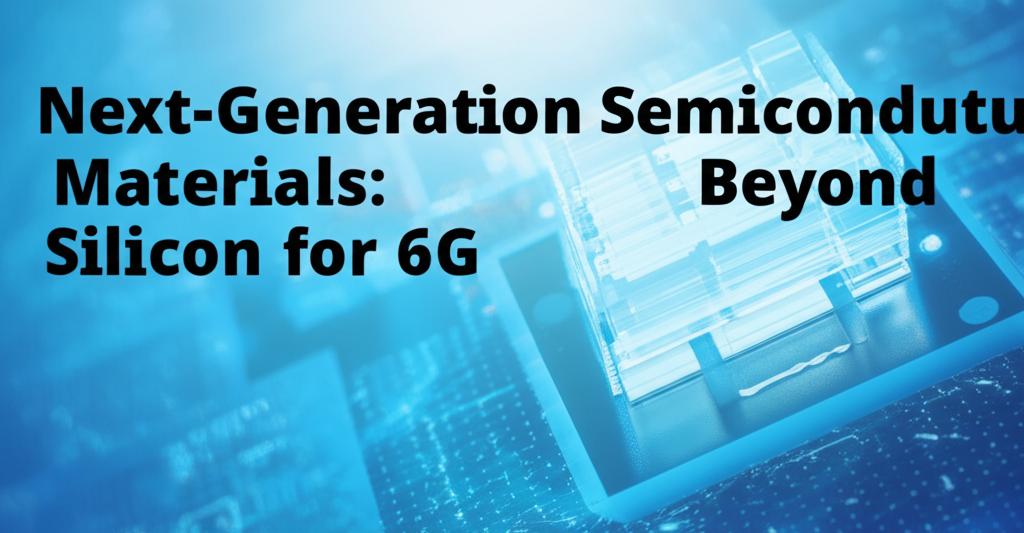The insatiable demand for faster, more reliable, and ubiquitous wireless communication has set the stage for the sixth generation of wireless technology, or 6G. Set to operate at unprecedented terahertz (THz) frequencies, 6G promises to unlock a new era of applications, from holographic presence and autonomous systems to the Internet of Everything (IoE). However, the very foundation of current electronics, silicon, faces significant limitations at these extreme frequencies, paving the way for a new class of semiconductor materials.
Silicon, the workhorse of the semiconductor industry for decades, struggles to maintain performance and efficiency at the high radio frequencies required for 6G, typically above 100 GHz and extending into the sub-terahertz range. This is primarily due to its inherent material properties, such as lower electron mobility and breakdown voltage compared to other compound semiconductors. As 6G pushes towards Tbps data rates and microsecond latencies, the limitations of silicon in terms of gain, output power, and efficiency become increasingly apparent.
To overcome these hurdles, researchers are actively exploring a range of
next-generation semiconductor materials:
- Gallium Nitride (GaN): GaN has emerged as a strong contender, particularly for power amplifiers in 6G systems. It offers higher efficiency, power density, and thermal resilience compared to silicon. GaN-on-silicon technology is also gaining traction, aiming to combine the performance benefits of GaN with the manufacturing scalability of silicon. Recent developments have shown GaN's capability to operate across wide frequency bands, potentially supporting 4G, 5G, and future 6G systems with a single amplifier, leading to more power-efficient base stations.
- Indium Phosphide (InP): InP is another critical material, especially for applications requiring operation at frequencies approaching or exceeding 1 THz. InP-based devices, such as heterojunction bipolar transistors (HBTs), demonstrate superior speed, output power, and energy efficiency at these sub-THz frequencies. Efforts are underway to mature InP process technology, including growing InP on silicon substrates, to make it more cost-effective and scalable for mass production. European consortiums like Move2THz are specifically focused on building a robust InP semiconductor ecosystem.
- Gallium Arsenide (GaAs): While facing competition from GaN and InP at the highest 6G frequencies, GaAs remains a relevant III-V compound semiconductor recognized for its high-frequency performance due to high electron mobility. It has a history in RF applications and could still play a role in certain 6G components.
- Silicon-Germanium (SiGe): For frequencies up to around 150 GHz, especially for shorter-range communication, current CMOS and SiGe technologies are considered sufficient. SiGe offers a pathway to extend silicon's capabilities to higher frequencies than CMOS alone. However, for longer-range applications and higher power amplification, III-V materials are often preferred.
- Two-Dimensional (2D) Materials: Materials like graphene and other 2D monolayers are showing significant promise for future 6G applications. These atomically thin materials possess unique electronic and optical properties arising from quantum confinement effects, such as tunable bandgaps and high carrier mobility. Graphene photonics, for instance, is being explored for up/down conversion of high-speed data streams in the sub-THz range. Research into 2D material heterostructures is also active, aiming to combine the strengths of different 2D materials for enhanced device performance.
- Metamaterials and Other Novel Approaches: Beyond direct semiconductor replacements, research is also delving into metamaterials, which are engineered structures with properties not found in nature. These can be used in reconfigurable intelligent surfaces (RIS) to actively steer and amplify 6G signals, enhancing coverage and efficiency. Other novel material approaches include low-loss dielectrics, advanced ceramics like low-temperature co-fired ceramics (LTCC), and even less conventional options like silica foams or wood-based composites for specific 6G applications.
Despite the exciting potential of these next-generation materials, several challenges must be addressed. Cost-effective manufacturing and scalability remain significant hurdles for many compound semiconductors compared to mature silicon processes. Integrating these new materials with existing silicon-based platforms (heterogeneous integration) is a key area of research to leverage the strengths of both. Ensuring the reliability and reducing defects in these novel materials are also critical for commercial viability. Furthermore, the precise performance targets for 6G are still evolving, making it a dynamic landscape for materials research.
The journey beyond silicon for 6G is not just about replacing one material with another; it's about a paradigm shift in how semiconductor devices are designed, fabricated, and integrated. Collaborative efforts across industry and academia are crucial to accelerate the development and commercialization of these advanced materials. As 6G networks are anticipated to begin commercialization around 2030, the innovations in semiconductor materials today will be foundational to realizing the transformative potential of this next wireless revolution.

